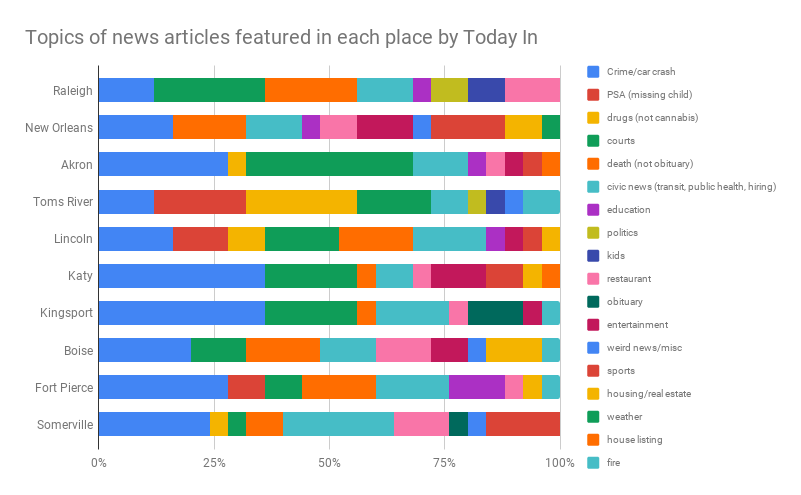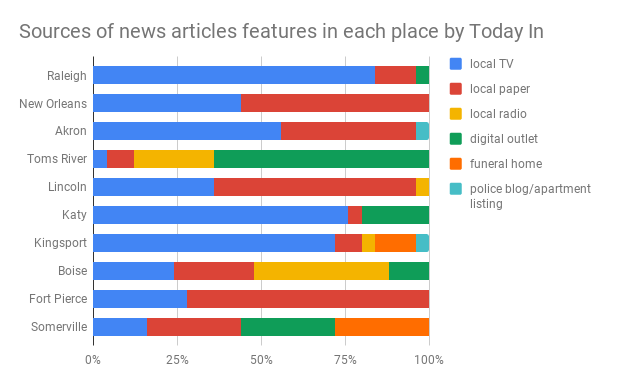
But what kind of local news is Facebook providing in the places where Today In is live? Crime alerts and court decisions, mostly. The crime-and-courts-and-death beats — often just TEEN MISSING or SEXUAL PREDATOR ON THE LOOSE stuff, barely digested police alerts — represented more than half of the stories in Today In during a week-long experiment I ran recently. For a company that says it wants to “encourage meaningful interactions between people,” it doesn’t immediately strike you as the sort of content that’s going to build social cohesion, develop a sense of place, or otherwise do the good things that local news can do.
If you don’t know what “Today In” is, don’t feel too bad — not many Facebook users do. Only about 1.1 million users have opted in to it in their app. (Check the hamburger-menu tab; you may have to tap on “More” to see it. It may sometimes pop up in your News Feed.) It began in a few test cities in early 2018 and it’s now live in 400-plus cities in the United States.
To see what sort of news it was surfacing, I tracked Today In’s stories for 10 different cities over a Monday–Friday period. The cities are a mix of big and small, some of which you’ll probably recognize without the state — Raleigh, New Orleans, Akron, Boise — and some you might not — Somerville, Massachusetts; Kingsport, Tennessee; Fort Pierce, Florida; Katy, Texas; Lincoln, Nebraska, and Toms River, New Jersey. Some are close to places Facebook considers “news deserts”; others still have a comparatively rich local news ecosystem. I noted the first five stories shared each afternoon in each city. (You can get more by tapping a “see more” button.) It’s not the most scientific method, but it’s a pretty good scan of what Facebook is surfacing.
What did I see? Satire, obituaries from funeral home websites, lots of local TV, and a weird network of sites that scrape other local news and yet somehow make it into Facebook’s scanner. And again, over half of the news was just crime, courts, and dead bodies.
As an example, here’s what was on offer this morning from Today in Somerville, where I live. (For those unfamiliar, Somerville is a city of 75,000 people, home to Tufts University, and a common place to live for people who work or go to school at Harvard, MIT, or other area colleges.)
The next five stories, if you tap “See More,” include two stories out of Everett (the next city east; both stories are three days old), and one about a restaurant opening in Boston’s North End (only a day old!). The other two stories, each four days old, are from another aggregator site called Purely Boston that seems to exist only to lift the headline, photo, and first paragraph from real news organizations — in this case The Boston Globe and the just links to Boston Herald. (Even that original Herald story is a total of two sentences plus six embedded tweets about Lori Loughlin’s appearance in Boston federal court, which was five days ago.)
I mean, that’s Somerville in a nutshell, right?
“Our goal is to show more information that connects people and publishers to their local communities as part of our commitment to show high quality news that’s broadly trusted, informative and relevant,” Facebook outlined in a March 2018 post expanding Today In further.
I asked Facebook about this, and a spokesperson said that Today has caps on crime and clickbait that are already in place:
We take into account a variety of signals similar to what we use when ranking News Feed, such as freshness and engagement (e.g., likes, reactions, comments, shares). While we strive to show people new content daily, the availability of new content depends what local Pages, Groups, and news publishers are posting.
One of our goals with Today In is to maximize long-term value and provide a mix of relevant content for a community — not to gain short-term engagement with clickbait. We know from research that people think it’s important to hear about a variety of local topics. We actually have a cap in place on the amount of articles related to crime & tragedy we show in the interest of giving people a well-rounded snapshot of their community. We’re working on getting this right and we strive for balance. That’s one of the reasons that we’re still testing Today In.
But if there are caps on crime and clickbait in place, I don’t want to think what Today In would look like without them. Here’s how the stories broke down in my classification system in each city I looked at:

This means I spent the week learning about drug busts and the saga of a missing teen in Toms River (she’s safe) from the websites of police scanner trackers and saw a lot of repeated articles about Boise’s 30-year Chinese restaurant mainstay closing up. Raleigh rallied in its coverage of how a guy tried to shoot up a Barnes & Noble, a school board near Fort Pierce contemplated buying a new office building, and there were car crashes and people died. Everywhere. (Three of them in a triple homicide! That happened four years ago!) In Somerville and Kingsport in particular, I also learned about people who’d died in not particularly newsworthy ways (and about Beatrice Pleasant’s sweetly random giveaways of her hand-embroidered handkerchiefs) through funeral home obituaries.
Where did these stories come from? It varied substantially by city, but local TV was the overall leader:

Is the news shared in Today In high quality? That depends on your definitions, of course. Is it informative? Are the topics relevant? Does it make Facebook users better citizens of their communities? Or, to frame it in Facebook’s language, is time spent reading Today In time well spent?
Also, what wasn’t I seeing? What was Facebook, in its probably well-intentioned local news section, missing in its system? Here’s how the Today In system works, via snazzy infographic:

Today In’s system only pulls links that are shared on Facebook. And it’s difficult to know if you’re finding all possible sources of meaningful news in a given area at a given time. But what if Mrs. Pleasant’s obituary was replaced with another article from the Kingsport Times-News — like a reporter’s dispatch from a conference about housing affordability or even the paper’s Civics 101 explainer? Sure, maybe those received little reaction in the News Feed — and as Mark Zuckerberg said last year, “encourage meaningful interactions” is the standard of worthiness for news now, not “just a passive experience” of being, you know, informed. But I suspect that the people who have opted in to Today In — people literally asking for more local news — care about housing options and government. (Even the local cheer teams competing at Disney got plenty of engagement; we see you, proud grandparents.)
The next day the Times-News’s Facebook page shared a story about the neighboring town’s police chief resigning because of “aldermen who are interfering with” his job. Why was that not in Today In, instead of four stories about crime and death and one car crash story?

And over in Raleigh, North Carolina, another major metropolitan area with a relatively robust local media environment, 80 percent of stories came from local TV. There were only two stories from The News & Observer — both about restaurant openings! Shake Shack! — despite ongoing coverage of “sanctuary sheriffs” state legislation, a bill about retired teachers’ benefits, neither of which showed up in Today In, among other reporting. And local TV stations covered more than shootings and child porn arrests there, too — but Today In doesn’t quite demonstrate that. Instead, you get: car crash, car crash, sex offender, house fire, shooter.

Fort Pierce is in one of University of North Carolina professor Penelope Abernathy’s news deserts, with zero newspapers headquartered in St. Lucie County. (Though Gannett’s Treasure Coast newspapers consider it part of their coverage area.)
What does Facebook consider local news for them, then? Around 70 percent of the links come from the Treasure Coast papers and 30 percent from local TV, with more than half focusing on crime, death, and courts. (This Treasure Coast story on a burglar breaking into Subway with a crowbar was repeated over three days.) This story on “Alligator Ron” potentially joining a water management board (Florida, man) despite a $25 million possible conflict of interest didn’t make it into Friday’s lineup, though the Subway burglar, another repeated story about a fatal train crash, and an article about a woman charged for not informing her partner she is HIV positive all did.
Beyond that four-year-old homicide story in Idaho, a number of quite old stories made it into the mix. In Toms River — part of an area where Facebook identified as “sometimes not enough local news to launch Today In” — there was this local radio writeup of a woman’s arrest for heroin possession in a Joe’s Crab Shack. In 2016. The same day, Today In pushed another story from the same AM radio site, a traffic stop-turned-drug-bust story that was, again, from 2016.
And not all stories were actually local. The “American Idol” onstage proposal that made Katy Perry ugly-cry was touching (if not as precious as Beatrice’s handkerchiefs), and Jussie Smollett’s court case in Chicago made national headlines — but neither one is particularly tied to Katy, Texas. But because local TV stations shared them — something local TV stations do a lot — they showed up in Today In Katy. (Along with: stabbing, drug crime, stabbing.)
Katy, like Somerville, also drew in scraped news from a network of sites called Big City Informer — Boston Informer, Houston Informer, etc. — which include only copied text and a link to the actual information on other local sites.
What’s that scraped garbage doing in there? Facebook didn’t respond specifically respond to that question beyond a reminder that it’s using the same “integrity filters to prevent objectionable content (e.g. misinformation, hate speech, clickbait, etc.) from surfacing” with Today In as with News Feed.
Crime, death, and outrageous-but-maybe-not-really-local-news — that’s what a lot of local TV news and digital sites thrive off of, of course. But the value of local journalism comes through active reporting that shows residents how they can be a member of their community. There’s more happening in the newsrooms than these quick-hit stories, and Today In doesn’t represent anything close to the best of what local newsrooms offer to their communities.
Four days ago — which seems to be “BREAKING NOW” on Today In’s timescale — Facebook exec and former Washington Post journalist Anne Kornblut said that
Facebook’s core mission is community and building community. And local news is one of the most important ways you can actually build community. We’ve seen people come together around local news in a way that I think it would be devastating if it were somehow lost.
Yes, it would.